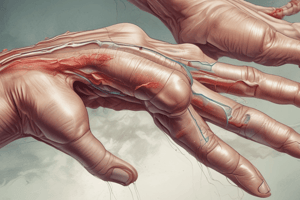Podcast
Questions and Answers
Which primary muscle is responsible for abducting the little finger at the metacarpophalangeal joint?
Which primary muscle is responsible for abducting the little finger at the metacarpophalangeal joint?
- Flexor pollicis brevis
- Interossei dorsales
- Abductor digiti quinti (correct)
- Flexor pollicis longus
What is the range of motion for the abduction of fingers?
What is the range of motion for the abduction of fingers?
- 0° to 25°-30°
- 0° to 15°
- 0° to 20°-25° (correct)
- 0° to 90°
Which of the following muscles is NOT involved in thumb flexion?
Which of the following muscles is NOT involved in thumb flexion?
- Flexor pollicis brevis
- Interossei dorsales
- Abductor pollicis longus (correct)
- Flexor pollicis longus
What is the nerve supply for the Flexor pollicis longus muscle?
What is the nerve supply for the Flexor pollicis longus muscle?
What action do the interossei dorsales muscles perform?
What action do the interossei dorsales muscles perform?
What is the range of motion for the thumb's interphalangeal joint flexion?
What is the range of motion for the thumb's interphalangeal joint flexion?
Which condition is a result of weakness in thumb flexors?
Which condition is a result of weakness in thumb flexors?
Which action is primarily performed by the Flexor pollicis brevis?
Which action is primarily performed by the Flexor pollicis brevis?
Flashcards
Finger Abduction Muscles
Finger Abduction Muscles
These muscles move fingers away from the center axis.
Interossei Dorsales
Interossei Dorsales
Muscles that abduct fingers, flexing at the metacarpophalangeal joint while extending the interphalangeal joint.
Abductor Digiti Quinti
Abductor Digiti Quinti
Abducts the little finger from the center axis.
Thumb Flexion Range of Motion
Thumb Flexion Range of Motion
Signup and view all the flashcards
Flexor Pollicis Longus
Flexor Pollicis Longus
Signup and view all the flashcards
Flexor Pollicis Brevis
Flexor Pollicis Brevis
Signup and view all the flashcards
Finger Abduction ROM
Finger Abduction ROM
Signup and view all the flashcards
Thumb Flexion ROM
Thumb Flexion ROM
Signup and view all the flashcards
Study Notes
Fingers, Joints Abduction, and Thumb Flexion
-
Objective: Students will be able to identify the muscles involved in finger abduction and thumb flexion, the range of motion, and the effects of weakness of thumb flexors.
-
Content:
- The anatomy of the primary muscles involved in finger abduction and thumb flexion.
- Range of motion for finger abduction and thumb flexion (0° to 20°-25° for fingers, and ranges for thumb).
- Effects of weakness in thumb flexor muscles.
Finger Abduction Motion
-
Primary Muscles:
- Interossei dorsales
- Abductor digiti quinti
-
Range of Motion: 0° to 20°-25° (finger abduction)
-
Anatomy of Interossei Dorsales:
- Origin: Inner aspects of metacarpal shafts.
- Insertion: Proximal phalanges, dorsal extensor expansion on radial side of index and middle fingers, ulnar side of middle and ring fingers.
- Nerve Supply: Ulnar nerve.
- Action: Abduct fingers away from axis of middle finger. Flex the metacarpophalangeal joint while extending the interphalangeal joint.
Anatomy of Abductor Digiti Quinti
- Origin: Pisiform bone, pisohamate ligament, flexor retinaculum
- Insertion: Ulnar side of proximal phalanx of little finger, extensor expansion
- Nerve Supply: Ulnar nerve
- Action: Abducts little finger at the metacarpophalangeal joint
Flexion of Metacarpophalangeal and Interphalangeal Joints of Thumb
-
Primary Muscles:
- Flexor pollicis longus
- Flexor pollicis brevis
-
Range of Motion:
- Thumb-metacarpophalangeal joint flexion: 0° to 60°-70°
- Thumb interphalangeal joint flexion: 0° to 90°
-
Anatomy of Flexor Pollicis Longus:
- Origin: Anterior surface of radius below the anterior oblique line and adjacent interosseous membrane.
- Insertion: Base of distal phalanx of thumb
- Nerve Supply: Median nerve
- Action: Flexes distal phalanx of thumb
-
Anatomy of Flexor Pollicis Brevis:
- Origin: Flexor retinaculum and tubercle of trapezium
- Insertion: Base of proximal phalanx of thumb
- Nerve Supply: Median nerve
- Action: Flexes metacarpophalangeal joint of thumb
Effects of Weakness
-
Flexor pollicis longus:
- Weakness reduces distal phalanx flexion, making it difficult to hold objects and pick things up.
-
Flexor pollicis brevis:
- Weakness reduces proximal phalanx flexion, making it difficult to grip objects.
Studying That Suits You
Use AI to generate personalized quizzes and flashcards to suit your learning preferences.
Description
This quiz focuses on the muscles involved in finger abduction and thumb flexion, exploring their anatomy, range of motion, and the impact of muscle weakness. Students will identify key muscles like the interossei dorsales and learn about their function and nerve supply.




